Kern River Tournament
By
Carl Wuebben
I caught one trout about 12 inch. dropped it before i could take a photo, one sucker and four pikes minnows about 6 inches long on Friday. Rick P got a 35cm and a 30cm trout in the a.m. with me in the area i was controlling for the tournament Saturday. He was using a two fly rig for the first hour and got nothing then Gary Applebee stopped by to check on his student hahahah (just kidding- Rick is a very good fisherman on his own) and told him to think outside the box and do as Guy Jeans from the Kern river fly shop said and change the menu, and he did. He threw on a third fly (a nymph ) so I boulder hopped to the other side of the area and was ignoring him because of the no-fish-in-the-net syndrome he was having, and within ten or fifteen minutes he got his first fish of the day. I was on one side of the area and he was on the other so I came running over large and small boulders thru small spots of water and never missed a rock or slipped one bit and to this day I don't know how I made it there, in waders no less! But i met him right as he got to the side to measure the fish - a 35cm one not bad for a tough day on low and cold waters day fishing .




